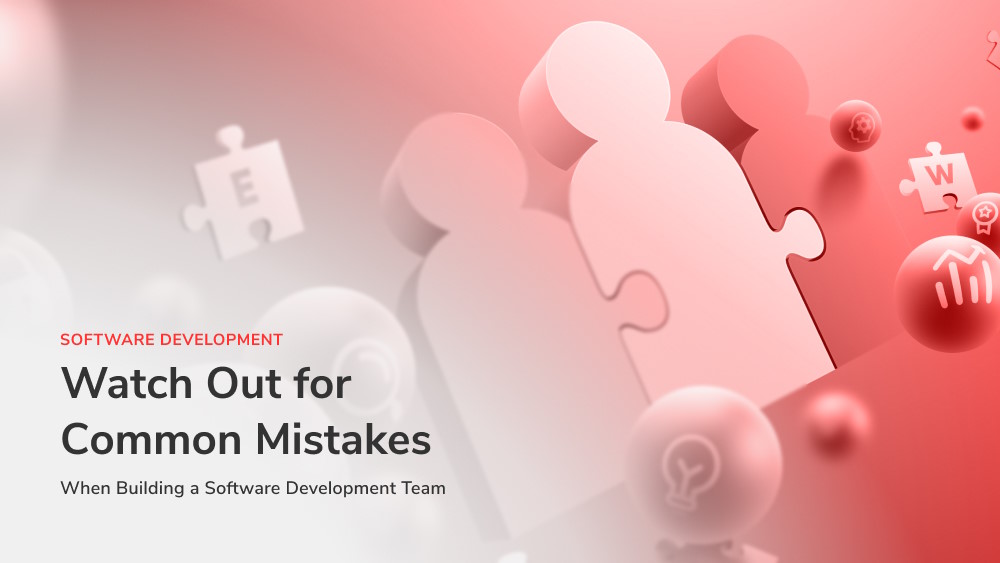Watch Out for Common Mistakes When Building a Software Development Team

Content Map
More chaptersNo matter what industry you are in, building a dedicated team of experts is the key to success. And for the respective sectors, such as information technology (IT), this fact is even more accurate. Nonetheless, building a software development team is no easy task. This is the reason why we have created this guide - to assist business leaders in their quest for success.
Key Elements of Building Software Development Teams – Efficient Ones
Oftentimes, a successful development team is measured by varying standards, such as efficiency, productivity, deep technical expertise, and so forth. In other words, you can tell whether it is an efficient team or not only when it is put into action. However, before the software developers can function on their own, such a team must be built with respect to a number of fundamental elements. The following are essentials to assemble a decent in-house team as well as monitor it.
Team Structure & Size
The first and foremost factor to hang on to is to structure your future development team in terms of size and roles. Ordinarily, the typical software development team structure consists of multiple roles and responsibilities, including a project manager, business analyst, product owner, product designer, software architect, and a number of software engineers.
Based on the project focus, the team size can either be kept lean with only the key roles or extended with full positions. Most of the time, project managers are assigned as the team lead - be responsible for coordinating and organizing efforts.
Software development teams fall into various categories:
- Technology Team: Consists of specialists who are highly proficient in technical areas (such as front-end development, back-end development, QA testing, DevOps, etc.) or a particular technology stack.
- Product Team: Includes generalists concentrating on all the matters around product development toward the project’s success.
- Matrix Team: Combines the skills and talent of both technology teams and product teams.
Each category will have a different structure, characteristics, and professionals included. Therefore, business owners should define the nature of their teams from the outset. Next steps, they need to draw a somehow like “family tree,” starting with the team leader and down to other team members. Don’t forget to describe their functions and scope of work respectively. Resource estimation should be focused on as well to ensure that the team scale is not too “humble” against the workload and requirements of complex projects as well as not too large compared to the budget. This procedure is similar to what you have to prepare before outsourcing a development team. The best team structure is the one constructed closest to your business goals and capabilities. With one, you can be confident to start gathering your own software team.
Technical Domain Knowledge
The next important element when team building is skills and expertise. An effective software development team must be well-versed in technical insights and possess a deep understanding of the project domain.
Each team member will be held accountable for different duties during the development process and complement each other to function as a smooth production line. As such, they are entailed to be knowledgeable about the technologies used in building a product as well as related fields, such as system architecture, security, data structures, algorithms, and so on. In the medium to large-size groups, the level of expertise and experience can also be diverse in order to cater to certain tasks. For example, software engineers can be divided into three skill tiers - junior, middle, and senior.
Therefore, as a project leader, you should determine the skillset required from team members and look for talented engineers who can perform their respective duties. To guarantee they meet the expectations and can stay abreast with new technologies over time, don’t forget to spend some time coaching and mentoring them. This will benefit the whole team in the long run and bring better results.
Being certified in certain areas are also a plus for shortlisted candidates. Resource selection is a vital concern in building a good software development team that should not be overlooked, as it affects the team’s performance and ability to build high-quality products in the most efficient manner.
Team Dynamics
This term refers to a collection of more minor elements, ranging from team communication, culture, collaboration, and collective efforts, that come into play when building and managing software engineering teams. All these traits are needed in order to ensure that all team members work together and coordinate their activities to achieve the desired outcome. Without solid team dynamics, it is impossible to build a software development team that functions and produces the highest quality products. Accordingly, hold the whole software development team accountable for the collective working environment and atmosphere to cultivate better cooperation, collaboration, and productivity.
There should be an effective communication process in place to ensure a high level of efficiency and a healthy working environment among team members as well as between project and development teams. This includes setting up collaboration tools, regular meetings, and other activities that support trust, openness, and mutual understanding between the two groups. Moreover, encourage them to move as a single unit, develop better solutions, and discover innovative ways of working together.
Apart from that, team leaders should also implement a feedback system in order to monitor the performance of individual team members as well as the group as a whole. Last but not least, a solid team culture should also be built from scratch when gathering developers. It serves as a foundation that brings members together and allows them to collaborate more efficiently within their working environment.
Avoid the Common Mistakes That Impede Your Effort for a Successful Software Development Team
In fact, the journey toward your right software engineering team is prone to blunders. Without caution, you may trip over unwanted mistakes when hiring developers for your team and end up with disastrous outcomes.

Start Hiring with No or Ambiguous Goals
Hiring software developers for your dev team without having a clear purpose or vague objectives in mind is a surefire recipe for disaster. You may think you have a clear vision, but without specifically setting up goals for the hiring process, you can easily fall into the wrong decisions. Thus, before jumping into the job market and starting recruiting, it is paramount to determine the project goals, job duties, roles to hire, and day-to-day activities. Map out the details and plan the recruitment process step by step.
Use Traditional Recruitment Methods Only
Conventional methods such as job postings and in-person interviews are still popular but don’t limit yourself to just these two channels. Consider using online platforms or staffing agencies as well to find potential hires that meet your criteria more efficiently.
In addition, most senior companies are still loyal to the traditional onsite working model. Instead, businesses nowadays should embrace remote and hybrid work. This enables them to expand their reach to tech talent outside the border of their local places. Moreover, they can reduce costs associated with relocation, office spaces, facilities, and other costs.
Rush to Hire Software Developers
It sometimes happens that project leaders are pressured to either complete the recruitment process as soon as possible, regardless of whether candidates are suitable or not, or miss the deadlines, which may draw a number of subsequent consequences (such as project delays). Needless to say, you can imagine the results derived from such a wrong move. You are stuck with inappropriate candidates who do not possess enough technical skills and soft skills or don’t even fit in with your corporate culture. Hence, it is important to take your time when recruiting software developers and make sure the hires meet all required qualifications before onboarding them.
Hiring Too Many or Too Few Candidates
When it comes to selecting software engineering candidates, a good practice is to pick a number of individuals that are commensurate with the size of the project at hand. Hiring too many people can create extra costs, which will no doubt put a strain on your budget. On the other hand, going short on resources could lead to not having enough manpower and cause delays in completing tasks. Any incompatibility between the team size and the project’s scope can have profound implications.
Attempt to Employ Every Team Member Full-time
It is true that having full-time employees offers more stability and control over their productivity, yet it doesn’t mean they are the only solution. There will be times when you should consider hiring part-timers or freelancers to finish specific tasks or fill temporary roles quickly.
Today, business leaders have two options either to augment their existing workforce with part-timers or outsource the work to a dedicated development team. This makes them more flexible to scale up or down depending on fluctuating project demands.
Instead of spending fixed costs on paying full-time wages for the entire team, you can employ the key people full-time and hire third-party contractors for the remaining roles and allocate them to specific tasks with more freedom. This will give you more flexibility in managing resources without having to commit to a long-term relationship with employees.
Let Your Talent Pool Be Limited by Geolocation
The current state of the IT talent shortage has created a growing problem for all tech businesses alike, especially small-sized companies that stand no chance against large corporations in the “war for talent.” Therefore, it is a fatal mistake to commit if you only source talent locally. In today’s tech world, talent is no longer limited to a certain location, but they are dispersed all over the world. If you limit your talent pool to only local area applicants, you’re missing out on great opportunities from outside your immediate vicinity.
Otherwise, you need to go even further. Being open to remote work can significantly broaden your recruitment pool and allow you to hire the best talent from all corners of the world. Even if there are concerns regarding long-distance collaboration, technology can mitigate this problem. Video conferencing tools, messaging platforms, and many other digital solutions help support successful remote teams and make communication easier than ever before. In recent times, tech companies have tended to recruit developers and utilize IT outsourcing services in Vietnam, which is a great example of sourcing top talent from overseas.
Do not get despondent just yet because you are coping with a software development team that does not seem to perform as expected. Most software development teams have one or several respective issues, and the “dream team “is not something you can achieve overnight. Still, it is possible to craft your own efficient development team and make the most of it if you can learn from this guide and apply the tips accordingly. Make sure you take into account all the points mentioned above, and you will make huge strides in making your software development team one of the best out there. If team setting up is none of your fortes, then it will be a wiser decision to consult with a top-tier software outsourcing service company to get the job done with an outsourced development team. Reach out to Orient Software for more advice on how to build and manage software development teams. Good luck and stay tuned.







